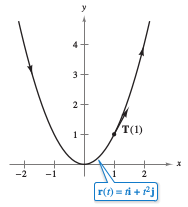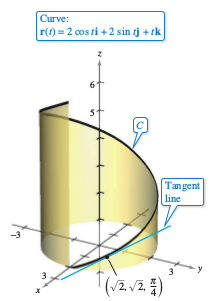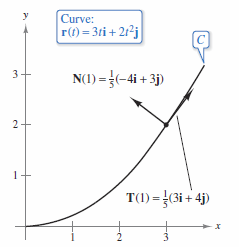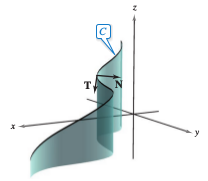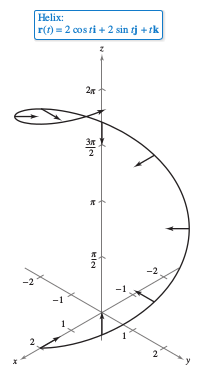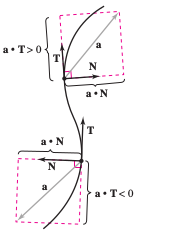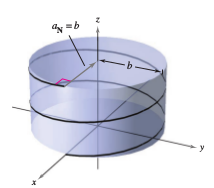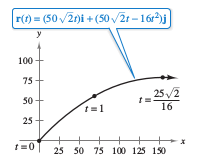Calculus III 12.04 Tangent Vectors and Normal Vectors
| Previous | Calculus III 12.03 Velocity and Acceleration |
| Next | Calculus III 12.05 Arc Length and Curvature |
Contents
- 1 12.4 Tangent Vectors and Normal Vectors
- 1.1 Tangent Vectors and Normal Vectors
- 1.2 Tangential and Normal Components of Acceleration
- 2 Internal Links
12.4 Tangent Vectors and Normal Vectors
- Find a unit tangent vector and a principal unit normal vector at a point on a space curve.
- Find the tangential and normal components of acceleration.
Tangent Vectors and Normal Vectors
Definition 12.4.1 Unit Tangent Vector
Let \(C\) be any smooth curve represented by \( \textbf{r} \) on an open interval \(I\). The unit tangent vector \( \textbf{T}(t) \) at \(t\) is defined as
- $$ \textbf{T}(t) = \frac{ \textbf{r}^{\prime}(t)}{ \| \textbf{r}^{\prime}(t) \|}, \: \textbf{r}^{\prime}(t) \ne \textbf(0) $$
Recall that a curve is smooth on an interval when is continuous and nonzero on the interval. The term “smoothness” is sufficient to guarantee that a curve has a unit tangent vector.
Example 12.4.1 Finding the Unit Tangent Vector
|
|
Find the unit tangent vector to the curve given by
where \(t=1\).
When \(t=1\), the unit tangent vector is
as shown in Figure 12.4.1. The unit tangent vector's direction depends on the curve's orientation. For the parabola described by
\( \textbf{T}(1) \) would still represent the unit tangent vector at the point (1,1), but it would point in the opposite direction. |
Example 12.4.2 Finding the Tangetnt Line at a Point on a Curve
|
|
Find \( \textbf{T}(t) \) and then find parametric equations for the tangent line to the helix given by
at the point
Solution For tangent vectors, the tangent line to a curve is a line that passes through the point and is parallel to the unit tangent vector, as shown in Figure 12.4.2. The derivative for \( \textbf{r}(t) \) is
which produces
The unit tangent vector is
At the point \( \left( \sqrt{2}, \sqrt{2}, \frac{\pi}{4} \right) \), \( t=\frac{\pi}{4} \) and the unit tangent vector is
Using the direction numbers, \(a=-\sqrt{2} \), \(b=\sqrt{2}\), and \(c=1\), and the point \((x,y,z)=( \sqrt{2}, \sqrt{2}, \frac{\pi}{4} ) \) the parametric equations (given with parameter \(s\) ) are listed below.
This tangent line is shown in Figure 12.4.2. |
Definition 12.4.2 Principal Unit Normal Vector
Let \(C\) be a smooth curve represented by \( \textbf{r} \) on an open interval \(I\). If \(\textbf{T}^{\prime}(t) \ne \textbf{0} \), then the principle unit normal vector at \(t\) is defined as
- $$ \textbf{N}(t) = \frac{ \textbf{T}^{\prime}(t)}{ \| \textbf{T}^{\prime}(t) \|} $$
Proof
There are infinitely many vectors that are orthogonal to the tangent vector \( \textbf{T}(t) \). One is the vector \( \textbf{T}^{\prime}(t) \). Applying Theorem 12.2.2 Property 7 produces
- $$ \textbf{T}(t) \cdot \textbf{T}(t) = \| \textbf{T}(t) \|^{2} = 1 \rightarrow \textbf{T}(t) \cdot \textbf{T}^{\prime}(t) = 0.$$
This normalization proves Definition 12.4.2.
Example 12.4.3 Finding the Principal Unit Normal Vector in Two-Dimensions
|
|
Find \( \textbf{N}(t) \) and \( \textbf{N}(1) \) for the curve described by \( \textbf{r}(t) = 3t\textbf{i} + 2t^{2}\textbf{j} \).
and
The unit tangent vector is
Apply Theorem 12.2.2 and differentiate \( \textbf{T}(t) \) with respect to \(t\) to produce
The principal unit normal vector is
When \(t=1\), the principal unit normal vector is
as shown in Figure 12.4.3. |
|
|
The principal unit normal vector can be difficult to evaluate algebraically. For two-dimensional curves the algebra can be simplified by finding
and observing that \( \textbf{N}(t) \) must be either
Because
it follows that both \( \textbf{N}_{1}(t) \) and \( \textbf{N}_{2}(t) \) are unit normal vectors. The principle unit normal vector \( \textbf{N} \) is one that points toward the curve's concave side, as shown in Figure 12.4.3. This also holds for curves in three-dimensions. That is, for an object moving along a curve \(C\) in three-dimensions, the vector \( \textbf{N}(t) \) is orthogonal to \( \textbf{T}(t) \) and the points along which the object is moving, as shown in Figure 12.4.3. |
Example 12.4.4 Finding the Principal Unit Normal Vector in Three-Dimensions
|
|
Find the principal unit normal vector for the helix \( \textbf{r}(t) = 2 \cos t \textbf{i}+ 2 \sin t \textbf{j} + \textbf{k}\).
Because
it follows that the principal unit normal vector is
Note that this vector is horizontal and points toward the \(z\)-axis, as shown in Figure 12.4.5. |
Tangential and Normal Components of Acceleration
For an object traveling at a constant speed, the velocity and acceleration vectors are perpendicular. This seems reasonable, because the speed would not be constant if any acceleration were acting along the curve. This is verified by noting that
- \( \textbf{r}^{\prime \prime}(t) \cdot \textbf{r}^{\prime }(t) = 0 \)
when \( \| \textbf{r}^{\prime }(t) \| \) is a constant, as shown in Theorem 12.2.2, Property 7.
For an object traveling along a curve at a variable speed the velocity and acceleration vectors are not necessarily perpendicular. For example, the acceleration vector for a projectile always points down, no matter where the curve goes.
In general, the acceleration, the tangential component, acts along the curve. While the normal component acts perpendicular to the curve. In order to determine these two components, the unit vectors \( \textbf{T}(t) \) and \( \textbf{N}(t) \), Use the unit vectors \( \textbf{T}(t) \) and \( \textbf{N}(t) \) to determine these components just as \( \textbf{i} \) \( \textbf{j} \) are used in representing vectors in two-dimensions. This is described in Theorem 12.4.1 below.
Theorem 12.4.1 Acceleration Vector
If \( \textbf{r}(t) \) is the position vector for a smooth curve \(C\) and \( \textbf{N}(t) \) exists, then the acceleration vector \( \textbf{a}(t) \) lies in the plane determined by \( \textbf{T}(t) \) and \( \textbf{N}(t) \).
Proof To simplify the notation, write \( \textbf{T} \) for \( \textbf{T}(t) \), \( \textbf{T}^{\prime } \) for \( \textbf{T}^{\prime }(t) \), and so on. Because \( \textbf{T} = \textbf{r}^{\prime } / \| \textbf{r}^{\prime } \| = \textbf{v} / \| \textbf{v} \| \), it follows that
- \( \textbf{v} = \| \textbf{v} \| \textbf{T} \).
Differentiating produces
| \( \textbf{a} \) | \(= \textbf{v}^{\prime }\) | Product Rule |
| $$= \frac{d}{dt} \left[ \| \textbf{v} \| \right] \textbf{T} + \| \textbf{v} \| \textbf{T}^{\prime } $$ | ||
| $$= \frac{d}{dt} \left[ \| \textbf{v} \| \right] \textbf{T} + \| \textbf{v} \| \textbf{T}^{\prime} \left( \frac{\| \textbf{T}^{\prime} \|}{\| \textbf{T}^{\prime} \|}\right)$$ | ||
| $$= \frac{d}{dt} \left[ \| \textbf{v} \| \right] \textbf{T} + \| \textbf{v} \|\| \textbf{T}^{\prime} \| \textbf{N}. \:\:\:\: $$ | \( \color{red}{ \textbf{N}=\textbf{T}^{\prime } / \| \textbf{T}^{\prime } \| }\) |
Because \( \textbf{a} \) is written as a linear combination with \( \textbf{T} \) and \( \textbf{N} \), it follow that \( \textbf{a} \) lies in the plane determined by \( \textbf{T} \) and \( \textbf{N} \).
The coefficients for \( \textbf{T} \) and \( \textbf{N} \) are called the tangential and normal components of acceleration and are denoted by
- $$ a_{\textbf{T}} = \frac{d}{dt} \left[ \| \textbf{v} \| \right] $$
and \( a_{\textbf{N}} = \| \textbf{v} \| \| \textbf{T}^{\prime} \| \). This can be written as
- $$ \textbf{a}(t) = a_{\textbf{T}}\textbf{T}(t) + a_{\textbf{N}}\textbf{N}(t). $$
Theorem 12.4.2 describes some formulas for \( a_{\textbf{N}} \) and \( a_{\textbf{T}} \).
Theorem 12.4.2 Tangential and Normal Components for Acceleration
|
|
If \( \textbf{r}(t) \) is the position vector for a smooth curve \(C\), where \(\textbf{N}(t)\) exists, then the tangential and normal components of acceleration are as follows.
Note that \( a_{\textbf{N}} \geqslant 0 \). The normal acceleration component is also called the centripetal component of acceleration.
|
Example 12.4.5 Tangential and Normal Acceleration Components
Find the tangential and normal acceleration components for the position vector given by
- \( \textbf{r}(t) = 3t \textbf{i} -t\textbf{j} + t^{2}\textbf{k}.\)
Solution Begin by finding the velocity, speed, and acceleration.
| \( \textbf{v}(t) \) | \(= \textbf{r}^{\prime } = 3 \textbf{i} -\textbf{j} + 2t\textbf{k} \) | Velocity vector |
| \( \| \textbf{v}(t) \| \) | \(= \sqrt{9+1+4t^{2}} = \sqrt{10+4t^{2}} \:\:\:\: \) | Speed |
| \( \textbf{a}(t) \) | \(=\textbf{r}^{\prime \prime} = 2 \textbf{k} \) | Acceleration vector |
By Theorem 12.4.2, the tangential acceleration component is
- $$ a_{\textbf{T}} = \frac{\textbf{v} \cdot \textbf{a}}{\| \textbf{v} \| } = \frac{4t}{\sqrt{10+4t^{2}}} \:\:\:\: \color{red}{ \text{ Tangential acceleration component}}$$
and because
- $$ \textbf{v} \times \textbf{a} = \begin{vmatrix} \textbf{i} & \textbf{j} & \textbf{k} \\ 3 & -1 & 2t\\ 0 & 0 & 2 \end{vmatrix} = -2\textbf{i}-6\textbf{j} $$
the normal acceleration component is
- $$ a_{\textbf{N}} = \frac{\textbf{v} \times \textbf{a}}{\| \textbf{v} \| } = \frac{ \sqrt{4+36}}{\sqrt{10+4t^{2}}} = \frac{2 \sqrt{10}}{\sqrt{10+4t^{2}}}. \:\:\:\: \color{red}{ \text{ Normal acceleration component}} $$
The alternative formula for \( a_{\textbf{N}} \) also works.
- $$ a_{\textbf{N}} = \sqrt{ \| \textbf{a} \|^{2} - (a_{\textbf{T}})^{2}} = \sqrt{ (2)^{2} - \frac{16t^{2}}{\sqrt{10+4t^{2}}} } = \frac{2 \sqrt{10}}{\sqrt{10+4t^{2}}} $$
Example 12.4.6 Finding \(a_{\textbf{T}}\) and \( a_{\textbf{N}} \) for a Circular Helix
|
|
Find the tangential and normal acceleration components for the helix given by
Solution
By Theorem 12.4.2, the tangential acceleration component is
In addition, because
the alternative formula for the normal acceleration component produces
the normal acceleration component as well. Note that the normal acceleration component is equal to the acceleration magnitude. In other words, because the speed is constant, the acceleration is perpendicular to the velocity, as shown in Figure 12.4.6. |
Example 12.4.7 Projectile Motion
|
|
The position vector for the projectile shown in Figure 12.4.8 is
Find the tangential acceleration components when \(t=0, \: 1\), and \(25\sqrt{2}/16 \).
The tangential acceleration component is
Plugging in the specified times yields
Figure 12.4.8 shows the maximum height is reached when \(25\sqrt{2}/16 \) and the tangential component is 0. This is reasonable because the direction is horizontal at that point and the tangential acceleration component is equal to the horizontal acceleration component. |
Internal Links
Parent Article: Calculus III 12 Vector-Valued Functions
